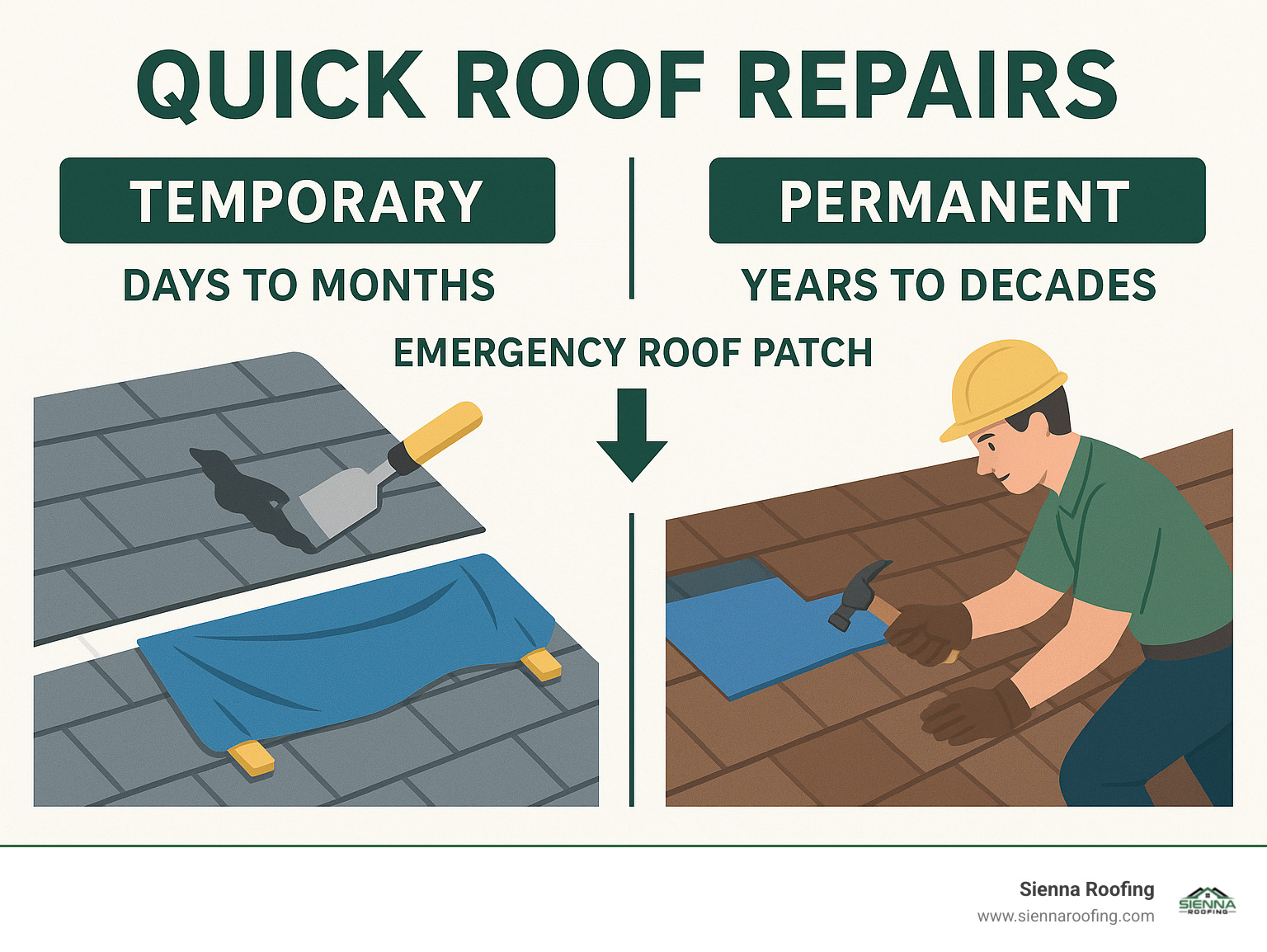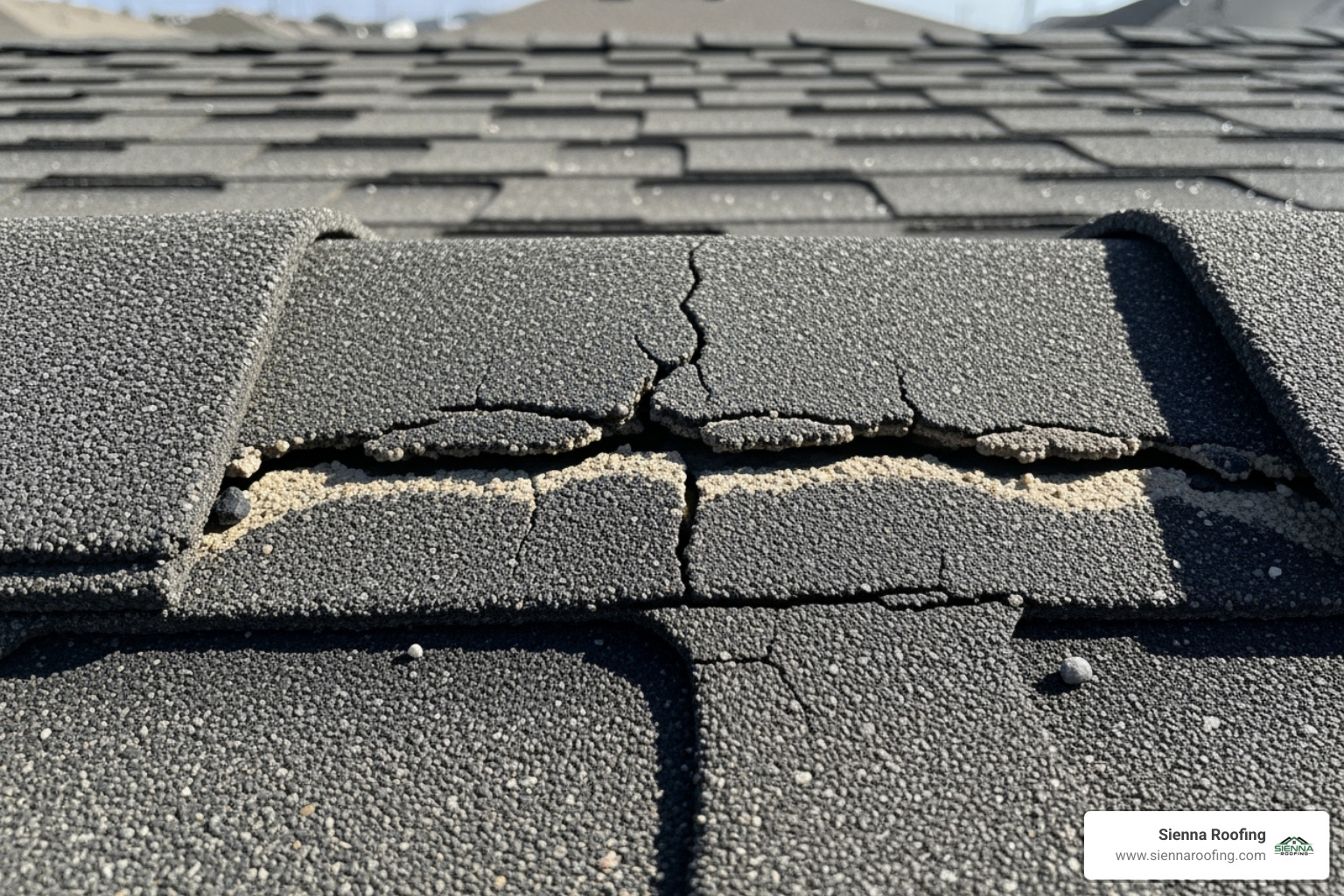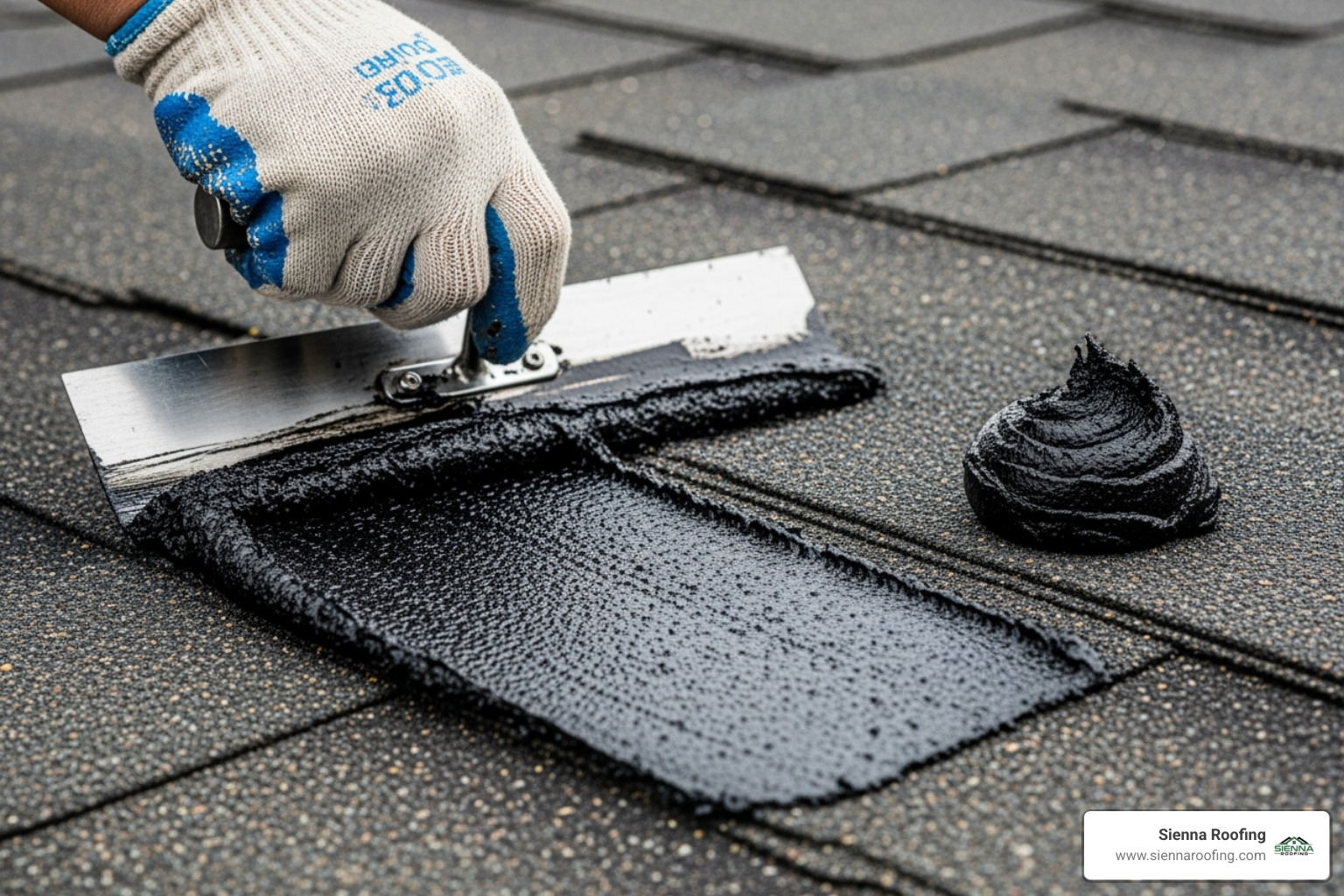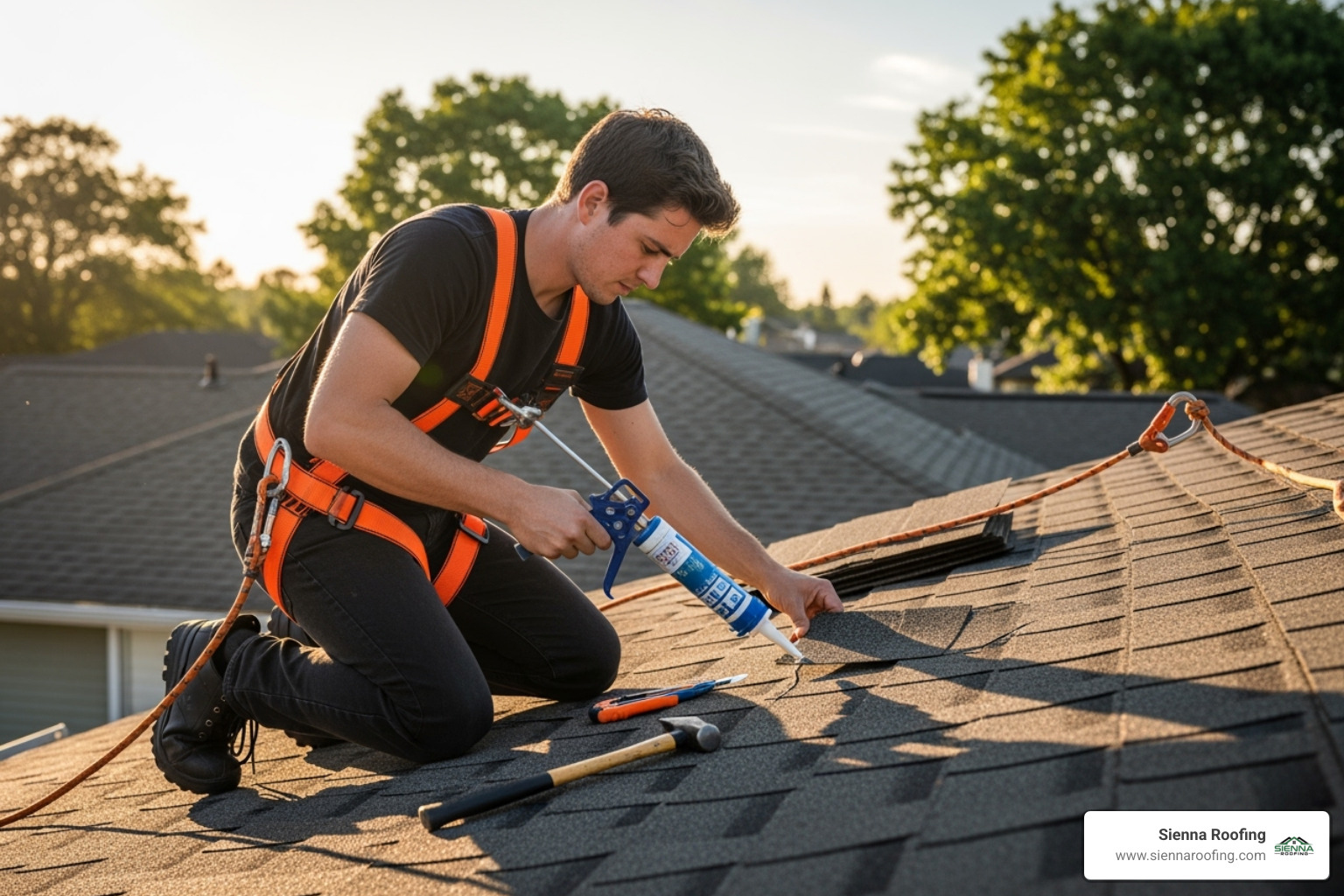Why Quick Roof Repairs Are Essential for Every Homeowner
Quick roof repairs are temporary solutions that can prevent thousands of dollars in water damage when your roof starts leaking at the worst possible moment. Whether it’s a weekend storm or a holiday emergency, these immediate fixes buy you precious time. Nearly 40% of homeowners will experience roof damage at some point, and when it happens, time is critical. A small leak can quickly escalate into major structural damage, mold growth, and expensive interior repairs if left untreated. While these DIY fixes are invaluable, they are not permanent. For lasting protection and true peace of mind, you need comprehensive roofing solutions from trusted experts who can address the root cause of the problem.
Common Quick Repair Solutions:
- Plastic sheeting or tarps – Cover large damaged areas temporarily
- Roofing cement – Seal small cracks and secure loose shingles
- Self-adhesive repair tape – Quick patches for minor holes and gaps
- Emergency shingle replacement – Replace missing or damaged shingles immediately
The key is understanding that these are temporary measures – not permanent solutions. Quick repairs typically last anywhere from a few days to several months, depending on weather conditions and the repair method used. For lasting protection, you’ll need professional emergency roof repair services to address the root cause.
I’m Andre Castro, CEO and founder of Sienna Roofing & Solar, and I’ve spent over five years helping homeowners steer both emergency situations and long-term roofing solutions. My experience with quick roof repairs has taught me that while temporary fixes are invaluable for immediate protection, they should always be followed by professional assessment and permanent repair.

When You Need a Quick Fix: Common Types of Roof Damage
Picture this: you’re enjoying a quiet Sunday morning when you notice a suspicious water stain spreading across your ceiling. Your heart sinks as you realize your roof has decided to spring a leak at the worst possible time. Don’t panic – understanding what type of damage you’re dealing with is the first step toward getting your home protected again.
Most roof emergencies fall into a few predictable categories, and knowing which one you’re facing helps you choose the right quick roof repair approach. Whether it’s storm damage from last night’s weather or simple wear and tear that finally gave way, these common issues can often be temporarily patched until professional roofing services can provide a permanent solution.

Damaged or Missing Shingles
Asphalt shingles take a beating from Houston’s unpredictable weather. Wind damage can lift and curl shingles like potato chips, while hail damage leaves behind pockmarks and cracks that weaken the material. Even without dramatic weather events, age-related wear makes shingles brittle and prone to breaking under normal stress.
When shingles get damaged or go missing entirely, they expose the underlayment beneath – your roof’s second line of defense. This creates a direct pathway for water to infiltrate your home, making damaged shingles a prime candidate for quick roof repairs.
The good news? Missing or damaged shingles are often the easiest emergency repairs to tackle temporarily. A piece of roofing cement or a replacement shingle can buy you valuable time until professional help arrives.
Leaks Around Flashing and Vents
Here’s where things get tricky. Flashing – those thin metal strips around chimneys, vents, and skylights – creates watertight seals where your roof gets interrupted. But these critical transition points are also common leak sources because they endure constant expansion and contraction.
Chimney flashing can pull away from the structure, vent pipe boots made of rubber can crack and rot, and skylight seals can degrade over time. Even tiny gaps in these areas can funnel surprising amounts of water into your home.
What makes flashing leaks particularly frustrating is that they’re often harder to spot than missing shingles. The water might travel along the flashing before dripping into your living space, making the actual leak source difficult to pinpoint from inside your home.
Punctures and Small Holes
Sometimes roof damage happens in an instant. Fallen branches during storms, debris impact from high winds, or even maintenance mishaps can create punctures that demand immediate attention.
Small holes might seem minor, but they’re like leaving a window open during a rainstorm. Water will find that opening and exploit it mercilessly. This is especially true for flat roofs, which don’t have the benefit of gravity helping water run off quickly.
Punctures on flat roofs are particularly problematic because water can pool around the damaged area, increasing the pressure and potentially enlarging the hole. These situations require immediate patching to prevent water from pouring directly into your property.
When you’re dealing with punctures or holes, time is absolutely critical. Unlike gradual deterioration, these breaches provide an immediate and direct path for water entry. For extensive damage, especially after major weather events, you might need comprehensive storm damage repair services beyond what temporary fixes can handle.
Your Go-To Guide for Quick Roof Repairs
When a sudden leak threatens your home, knowing how to perform quick roof repairs can be the difference between minor inconvenience and major disaster. These temporary solutions aren’t meant to replace professional work, but they’re absolutely essential for protecting your property until help arrives. Think of them as first aid for your roof – they stop the bleeding, so to speak, giving you time to arrange for proper roofing services without watching water damage spread through your home.
The key to effective emergency repairs is understanding which materials work best for different situations. For a comprehensive look at temporary patching, you can review these temporary roof leak patching methods.
Here’s what you need to know about your material options:
| Material | Pros | Cons | Typical Lifespan (Temporary) |
|---|---|---|---|
| Roofing Cement | Easy to apply, good for sealing cracks/small holes, adheres well. | Can be messy, not suitable for large areas, susceptible to weather degradation over time. | Days to a few weeks |
| Repair Tape | Self-adhesive, quick application, versatile for various materials. | May lose adhesion in extreme temperatures, not for structural issues, can be visible. | Weeks to a few months |
| Tarps | Covers large areas, prevents widespread water entry, affordable. | Requires secure fastening, can be unsightly, temporary measure only, wind can dislodge. | Days to a few weeks |
| Plastic Sheeting | Similar to tarps, widely available, inexpensive. | Less durable than tarps, prone to tearing, requires secure fastening, very temporary. | Days to a week |
Applying Materials for Quick Roof Repairs on Shingles
When dealing with damaged shingles, your approach depends on whether you’re sealing cracks or replacing missing pieces entirely. Roofing cement becomes your best friend in these situations – it’s like having a tube of super-strong glue that can handle weather.
For cracked or loose shingles, grab your trowel and apply roofing cement directly over the damaged area. Work it slightly under the shingle edges if they’re lifting, creating a seal that water can’t penetrate. If you’re dealing with a loose but intact shingle, carefully lift it up, spread cement underneath, press it back down, and secure it with a couple of galvanized nails. Don’t forget to cover those nail heads with more cement – exposed nails are just future leak points waiting to happen.
Missing shingles require a bit more creativity. If you have a spare shingle lying around, slide it into place and secure it with nails and cement. No spare? Cut a piece of sheet metal or copper to roughly match the shingle size. It won’t win any beauty contests, but it’ll keep the water out until professional help arrives.
Roofing tape offers another quick solution, especially for small holes or tears. Just make sure the surface is clean and dry before applying – wet surfaces and adhesive don’t play well together.

Quick Repair Methods for Metal Roofs
Metal roofs are tough, but when they do get damaged, the repair approach is quite different from shingles. The challenge with metal is finding materials that can handle temperature changes without cracking or losing their grip.
Roof sealant – specifically high-quality silicone or polyurethane – works wonders for small cracks and failing seams. Clean the area thoroughly first (this step is crucial for metal), then apply the sealant generously over the problem spot. Butyl tape is another excellent choice for metal surfaces. This incredibly sticky, self-adhesive tape forms a strong bond and stays flexible through temperature swings. Simply clean the surface, cut your tape to size, and press it firmly over the leak, smoothing out any air bubbles.
For larger punctures, specialized metal roof patches made of reinforced aluminum or rubberized material provide more robust temporary protection. These patches are designed specifically for metal surfaces and can handle the expansion and contraction that comes with temperature changes.
Addressing Leaks on Flat/EPDM Roofs
Flat roofs present their own unique challenges, mainly because water has nowhere to run off quickly. Whether you’re dealing with EPDM rubber or another flat roof material, the key is creating a flexible, watertight seal that can move with the roof.
EPDM repair tape is specifically designed for rubber roofs and creates an incredibly strong bond. Start by cleaning the area thoroughly – any dirt or debris will prevent proper adhesion. Peel off the backing paper and press the tape firmly over the tear or puncture, working out any air bubbles as you go.
Liquid rubber sealant offers another versatile option. You can brush or roll it over cracks, small holes, or problematic seams, and it forms a seamless, waterproof membrane as it cures. For larger tears or failing seams, self-adhesive patches combined with liquid sealant can provide a more comprehensive temporary fix.
Having the right tools makes all the difference when you’re racing against time and weather. Your flat roof repair kit should include: a stiff brush for cleaning, all-purpose cleaner compatible with your roof material, a utility knife for cutting patches, a roller or squeegee for applying patches smoothly, a caulk gun for liquid sealants, EPDM repair tape, liquid rubber sealant, and butyl tape for various situations.
These quick roof repairs are temporary solutions designed to buy you time, not replace professional assessment and repair. They’re your emergency response team, keeping your home dry until the cavalry arrives.
Safety Above All: The Non-Negotiables of DIY Roof Work
I can’t stress this enough: when it comes to quick roof repairs, your safety must come first. No leak is worth a trip to the emergency room, and no amount of water damage justifies risking your life. I’ve seen too many well-intentioned homeowners turn a simple repair into a dangerous situation because they skipped basic safety precautions.

Before you even think about climbing up there, take a hard look at the conditions. Never attempt roof work on a wet, icy, or windy day – period. That shingle that seems so easy to fix from the ground becomes a completely different challenge when you’re balancing on a slippery surface 20 feet up. I always tell my clients: if the weather doesn’t look perfect, wait another day.
Electrical wires are another serious hazard that many homeowners overlook. Keep a safe distance from any overhead lines, and be aware of where they run near your roofline. One wrong move with a metal tool or ladder could be fatal.
Here’s my rule of thumb: if you feel even slightly uncomfortable about the repair, or if the damage seems extensive, don’t hesitate to call professional roofing contractors instead. Your family needs you safe more than they need you to save a few dollars.
Essential Safety Gear
The right safety equipment isn’t optional – it’s your lifeline. When I’m training new crew members, I always start with gear because proper equipment can mean the difference between going home safe and going to the hospital.
Non-slip boots are absolutely critical. Regular sneakers or work boots just won’t cut it on a roof. Look for boots specifically designed for roofing work, with aggressive tread patterns that grip even slightly damp surfaces. Quality gloves protect your hands from sharp metal edges, rough shingles, and chemical burns from roofing cement. Trust me, a cut finger makes any repair much more difficult.
Safety glasses might seem like overkill for a quick patch job, but flying debris and splashing sealant can cause serious eye injuries. A simple pair of wraparound safety glasses costs less than $10 and could save your vision. A hard hat protects against bumps and falling objects – even a small piece of loose shingle can cause a concussion if it hits you at the wrong angle.
Most importantly, a fall protection system is non-negotiable for any work on steep roofs or at significant heights. This includes a properly fitted safety harness, a lifeline, and a secure anchor point. Yes, it takes extra time to set up, but it’s the difference between a controlled stop and a potentially fatal fall.
Safe Work Practices
Having the right gear is only half the battle – you also need to use it correctly. Proper ladder placement starts with firm, level ground. Your ladder should extend at least three feet above the roofline and be angled at a 4:1 ratio (for every four feet of height, the base should be one foot away from the wall). Always maintain three points of contact when climbing – two hands and one foot, or two feet and one hand.
Never work alone on a roof repair. Even the quickest fix requires a spotter on the ground who can steady the ladder, hand you tools, and call for help if something goes wrong. Your spotter should stay alert and avoid distractions like phone calls or other tasks.
Weather can change quickly, especially during storm season. Check the forecast before you start, and be prepared to stop work immediately if conditions deteriorate. A repair that could wait until tomorrow isn’t worth risking your safety today.
Stay aware of your surroundings at all times. Clear loose debris from your work area, test each step before putting your full weight down, and never overreach. It’s much safer to climb down and move your ladder than to stretch too far and lose your balance. Most roofing accidents happen because someone got comfortable and let their guard down.
The Temporary Lifespan: Knowing When to Call a Professional
Let’s be honest here – a quick roof repair is like putting a band-aid on a scraped knee. It stops the immediate bleeding, but it’s not going to heal a broken bone. Understanding this distinction is absolutely crucial for protecting your home’s structural integrity and your wallet in the long run.
These temporary patches can last anywhere from a few days to a few months, depending on the material you use and what Mother Nature throws at them. Think of it like a spare tire on your car – it’ll get you to the shop safely, but you wouldn’t plan a cross-country road trip on it!
The reality is that every quick roof repair is fighting a losing battle against time, weather, and the elements. That roofing cement you carefully applied? It’s going to crack and shrink as temperatures fluctuate. That repair tape that seemed so promising? UV rays will gradually break down its adhesive properties. It’s not a matter of if these temporary fixes will fail – it’s a matter of when.
Signs You Need a Professional Roofer Immediately
While a quick roof repair can successfully halt immediate water intrusion, certain red flags indicate that you need to skip the DIY approach entirely and call in the professionals right away. Ignoring these warning signs can transform a manageable repair into a home renovation nightmare.
Widespread damage is your first major red flag. If you’re looking at multiple leaks, large sections of missing shingles, or extensive visible damage after a storm, you’re dealing with more than a quick patch can handle. This situation requires a comprehensive assessment and potentially a full roof replacement.
Large holes or a sagging roof deck are clear indicators of significant structural damage that demands immediate professional attention. A sagging roof could signal water-saturated sheathing or compromised rafters, which poses a serious safety risk to you and your family. This isn’t the time to climb up with a tube of roofing cement.
Recurring leaks after applying a patch tell you that the underlying issue is more complex than initially thought. The source of the leak might be elsewhere entirely, or the damage extends far beyond what’s visible on the surface. Water has a sneaky way of traveling through your roof system before showing up as a drip in your living room.
Any structural issues – such as cracks appearing in your interior ceilings or walls, or a noticeable shift in your roofline – demand immediate professional intervention. These signs often indicate that water damage has progressed beyond the roof itself and into your home’s structural components.
If you can see visible sunlight peeking through your attic ceiling, you’re dealing with a significant hole or gap that needs urgent professional repair. This level of damage is well beyond what any temporary fix can address safely.
Don’t hesitate to schedule a professional roof inspection if you observe any of these critical signs. Our experts can accurately diagnose the problem and provide a lasting solution that protects your home properly.
The Limits of a Quick Fix
Here’s the truth that every homeowner needs to understand: a quick roof repair is designed to stop immediate water intrusion, not to withstand years of weather degradation and UV exposure. These patches simply aren’t engineered to create a permanent seal.
Over time, the materials used in quick fixes – whether it’s roofing cement, repair tape, or even tarps – will inevitably break down. Sunlight, temperature fluctuations, wind, and precipitation all work together to gradually weaken these temporary solutions. What seemed like a solid fix in dry conditions might fail spectacularly during the next heavy rainstorm.
Perhaps more concerning is the false sense of security that temporary fixes can create. While the immediate leak might be stopped, there could be hidden damage underneath that continues to worsen. Water can seep into roof decking, insulation, and even wall cavities, leading to rot, mold growth, and structural weakening – problems that are far more expensive and complex to fix than the original leak.
We’ve seen this scenario play out countless times: a small, easily repairable issue becomes a major headache because a temporary fix was left in place for too long. The temporary patch masks these developing issues, allowing them to fester unseen until they become serious problems.
That’s why understanding these limitations and knowing when to transition from a quick roof repair to a comprehensive, professional solution is critical for your home’s long-term health. To learn more about how we can provide durable, lasting repairs that actually solve the problem, explore our professional roof repair services.
Your Next Step: From Quick Fix to Lasting Solution
You’ve successfully stopped that immediate leak with a quick roof repair, and honestly, that’s a huge relief! But now comes the important part – turning that temporary patch into a permanent solution that will protect your home for years to come.
Think of it this way: your quick fix was like putting a band-aid on a cut. It stopped the bleeding, but for proper healing, you need more comprehensive care. The same principle applies to your roof. While your emergency patch has bought you valuable time, addressing the root cause of the leak with professional craftsmanship is what will give you true peace of mind.
Here in the Houston area, where we face everything from intense summer heat to sudden storms, your roof takes a real beating. That’s why having experienced professionals handle your permanent repair isn’t just recommended – it’s essential for your home’s long-term health and safety.
At Sienna Roofing, we’ve seen countless homeowners who started with a quick roof repair and then worried about when that temporary fix might fail. We understand that stress, and we’re here to eliminate it. Our comprehensive inspections don’t just look at the obvious damage – we examine the entire roofing system to identify any underlying issues that might not be visible from the ground.
What sets us apart is our commitment to personalized, community-driven service. We’re not just another roofing company; we’re your neighbors, serving Sugar Land, Missouri City, Katy, Richmond, Pearland, Rosenberg, Rosharon, Friendswood, Webster, Bellaire, and West University. We know these communities because we live and work here too.
Our team takes the time to explain exactly what we find, why it happened, and what it will take to fix it properly. No confusing jargon, no pressure tactics – just honest, straightforward communication about your roofing needs. We back every repair with our 100% satisfaction guarantee because we believe in doing the job right the first time.
When you’re ready to move beyond that temporary patch and invest in your home’s future, we’re here to help. Find a trusted roofer in Sugar Land, TX and let us transform your quick fix into a lasting solution that protects your family and your investment for decades to come.




